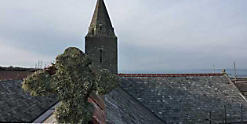The Restoration Of A Architectural And Cultural Gem: St. Germanus Church
Case Study
The restoration of a architectural and cultural gem: St. Germanus church on the Rame Peninsula in Cornwall

St. Germanus Church, Rame Peninsula, Cornwall, UK; photo courtesy of Le Page Architects, all rights reserved. The installation of DuPont™ Tyvek® shown in the photo is done according to UK building regulations (Part L and Part C of the Building Regulations) and meets the recommendations of British Standards 5250.
Historic buildings have a special charm that require careful and sympathetic preservation even if they sometimes need a little ‘discreet’ help from very modern materials. The medieval St. Germanus Church on the picturesque Rame Peninsula in Cornwall is one such architectural and cultural gem which now has a new roof benefitting from a reliable, hi-tech DuPont™ Tyvek® underlay.
This remote and exquisite XIII Century structure has continuously withstood the onslaught of time to serve its parishioners admirably, without even the need for contemporary amenities such as running water or electricity (its famed candlelit carol service draws international visitors). Nevertheless, the structure became vulnerable to the harsh coastal climate and had begun to lose roof slates at an alarming rate due to nail rot. This put the precious interior at risk from wind and water and so it was time for some vigorous fundraising by its community and the application of superior roofing solutions to ensure the longevity of the restoration.
The project involved removing and saving whatever original Cornish Delabole slates could be re-used, undertaking any necessary structural repairs and then installing DuPont™ Tyvek® advanced-breather membranes before re-fixing both salvaged and new tiles. The membrane was essential both to protect the church from weather during the construction process (and should any slates fail in the future) and to allow for the evaporation of any interstitial moisture or condensation.
Simon Crosbie, Director of Le Page Architects, (www.lepagearchitects.com) a Cornwall-based practice highly experienced in working with historic buildings, comments, “The church is very typical of the Cornish coast line with its rugged, simple architecture matching the surroundings.
Built mainly of slate stone, its fenestration is of local granite as is the Cornish slate roof. As with all Grade 1 listed buildings of this nature a purposeful philosophy has to be adopted to ensure corrective work is undertaken that protects the fabric without damaging or removing any of the historic "nature" of the architecture. In this particular case, the roofs had to be stripped as the slates and rainwater goods were failing.”

Simon Crosbie continues, “Due to the poor original levels where the slate roofs abutted the parapet walls, new granite copings have had to be set in place. This detail allows the correct lead soaker and flashing dimensions, and of course the DuPont™ Tyvek® membrane, to be turned up accurately behind. It was very important that we choose the right products for the new roof. Whilst the slates were sorted and those which still had a long lifespan reused alongside replacement Delabole slates, the requirement to have a reliable underlay of the highest specification was an absolute necessity, as it forms the second line of defence in case of wind-blown or water damage…and due to the structure’s locality this is a possibility over time.”
So now parishioners and visitors can continue to enjoy the distinctive beauty, calm and spiritual solace of St. Germanus at Rame in good faith that they are well protected from the elements. To learn more about the church and the restoration, please visit www.rameroof.co.uk
The roof work was undertaken by Western Counties Roofing.
